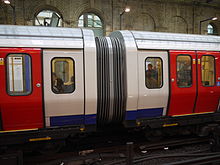伦敦地铁S7与S8型列车
| S7与S8型列车 | |
|---|---|
 一列大都会线S8型列车停靠阿默舍姆站 | |
 环线S7型列车内部 | |
| 概览 | |
| 制造 | 庞巴迪运输 |
| 产量 | 191列(S8:58、S7:133) |
| 制造年份 | 2008~2017年 |
| 服务时间 | 2010年7月31日~ |
| 主要用户 | 伦敦地铁 |
| 营运路线 | S7:环线、区域线、汉默史密斯及城市线 S8:大都会线 |
| 车辆基地 |
|
| 技术数据 | |
| 列车编组 |
|
| 编组长度 | S7:117.45 m S8:133.68m |
| 车辆长度 | DM:17440 mm NDM:15430mm |
| 车体宽度 | 2920[1]mm |
| 轨距 | 1435mm |
| 车体材质 | 铝合金 |
| 车门 | 每节6扇门 |
| 车辆定员 |
|
| 营运速度 | 100km/h |
| 起动加速度 | 1.3 m/s2 |
| 供电制式 | 750 V DC 第四轨供电 |
| 受流方式 | 集电靴 |
| 控制装置 | 庞巴迪运输制 IGBT-VVVF MITRAC TC1410 系列 |
| 其它事项 | |
| 技术平台 | Movia |
| 取代了 |
|
伦敦地铁S7与S8型列车(英语:London Underground S7 and S8 Stock),通常称为S型列车,是自2010年后伦敦地铁的一种浅层地底列车,其将取代在大都会线、区域线、汉默史密斯及城市线与环线上自1960及1970年代运行的A60、A62、C69、C77与D78型列车。
列车全部由庞巴迪运输的德比利特彻奇巷工场制造,总量为192列1403节,包括两个分支,用于环线、区域线和汉默史密斯及城市线的S7型列车以及大都会线的S8型列车,分别在于座位配置和车辆数量。两个型号都设有空调设备和低地台以便伤残人士可无障碍通行,并开放贯通道,容许列车运行时乘客在车厢之间移动。
根据伦敦交通局,S7与S8型列车是英国最大的单一型号列车订单[2],合共15亿英镑[3]。
列车于2010年7月在大都会线开始营运,2012年7月扩展至汉默史密斯及城市线,2012年9月完全取代大都会线上的A型列车;2013年9月扩展至环线,2014年2月完全取代环线和汉默史密斯及城市线的C型列车;2014年6月开始在区域线上营运,并在2017年4月取代区域线余下的D型列车。
概要
S指的是市郊(suburban)[4],沿用伦敦地铁浅层路线车辆编号规律:大都会线的A型列车往阿默舍姆(Amersham)[5],C型列车在环线(Circle line)及汉默史密斯及城市线(Hammersmith & City line)上行走[6],D型列车在区域线(District line)行走[7]。
作为庞巴迪Movia家族一员,S型列车包括133列S7型七节列车供环线、区域线与汉默史密斯及城市线使用,以及58列S8型八节列车供大都会线使用。另外当八节S8型列车进行工程修正和ATC调适时,还有3列额外的八节列车可使用,称为S7+1,用于大都会线。这些列车形成S7型的七节列车以及另一部S7型的一节车厢,组成八节列车。这些列车沿用S7型的全横向座位,故此可以与其余S8型区别。这些列车在2018年重组回七节列车服务环线、区域线和汉默史密斯及城市线。S8型列车在2010年至2012年间逐步投入服务,2012年9月起只以该型号列车运行。
S型列车比过去列车有更高的加速度,达1.3 m/s2(2.9 mph/s),但最高速度只有100 km/h(62 mph),比A型列车稍慢13 km/h(8 mph),仍比C型和D型列车快。过渡期间,S型列车需要控制表现以配合旧款列车的信号系统和避免列车堵塞。S8型列车座位有306席,比A型列车448席下跌了32%,但可容纳额外25%站立乘客(1,226名,后者976名),并设有轮椅专用空间[2]。
列车的供电电压亦由DC 630V升至DC 750 V,此举容许提升效能,亦额外提供空调以及再生制动所需电力[1]。
现时S型列车在大都会线和区域线全线,以及汉默史密斯及城市线和环线的大部分路段均为手动控制。拉蒂默路至汉默史密斯段在2019年3月转换为自动控制[8]。
特征

S型列车全车设有空调,浅层隧道容许排出热空气[2],而浅层路网三分之二都位于开放空间[9]。S型列车带有再生制动,回送约20%的能量并提高能源效率[10]。


车辆两端的显示屏显示两行文字:上方显示列车终点站,下方显示路线名称。内部而言,S型列车的点阵显示器比D型列车大(A型和C型列车没有点阵显示器)。点阵显示器显示终点站和路线,并可显示其他讯息,如安全通过。外面也设有点阵显示器,文字交替显示目的地和路线,S8型列车额外显示停车规律(快车、半快或各停)。S8型列车是大都会线首列设有点阵显示器和自动广播的列车。
S型列车是伦敦地铁第一款设有空调的列车,由三菱公司提供,并设有两条电路,其中一条电路短路时仍有50%容量可用[9]。全线都设有贯通道,类似伦敦地上铁的378型列车以容许乘客由较拥挤的车厢移动到较宽敞的车厢,以提供额外的站立空间来保障人身安全。闭路电视容许司机观察每节车厢,而轨道至列车视像连接容许司机在离站前观察列车外部[9]。每个驾驶室都设有折叠楼梯以便紧急疏散时使用[11]。
S型列车设有悬臂座位以便清洁和取得储存空间[12]。两个型号的座位排列有所不同。S7型列车用于城市内线,客量较多,故只使用横向座位。S8型列车用于远郊的长距离路线,同时设有横向和竖向座位,每列列车都设有4个轮椅空间。S7型列车全长117.45米(385英尺4英寸),S8型列车则为 133.68米(438英尺7英寸)长[13]。
为避免意外触碰紧急按钮,轮椅旁的紧急按钮设有盖子。
基于全车均有贯通道,故此所有S型列车皆可在全部浅层路线营运,车站月台短于车辆时可采用选择性车门操作。S7型列车每列七节,S8型列车每列八节。
设计标志
作为交通设计计划活动的一部分,2015年10月15日,公众投票后两个月,贯通型S型列车获选为10大最喜爱的标志设计[14][15]。
参见
参考资料
- ^ 1.0 1.1 S stock | Transport for London. 2013-12-29 [2018-03-12]. 原始内容存档于2013-12-29.
- ^ 2.0 2.1 2.2 Metro — London, United Kingdom. Bombardier. [27 January 2011]. (原始内容存档于2010-12-13).
- ^ Metropolitan Line air-conditioned Tube trains launched. BBC News. 2 August 2010 [30 January 2011]. (原始内容存档于2022-04-07).
- ^ Research Guide no 19: A brief history on the Hammersmith and City line (PDF). Transport for London: 4. 4 September 2013 [20 July 2019]. (原始内容 (PDF)存档于2022-02-23).
- ^ Bruce, J. Graeme. Steam to Silver: A history of London Transport Surface Rolling Stock. Harrow Weald: Capital Transport. 1983: 110 [1970]. ISBN 0-904711-45-5.
- ^ Bruce 1983,第114页
- ^ Bruce 1983,第118页
- ^ ATO, a Go-go: Signalling the SSR. London Reconnections. [2022-04-25]. (原始内容存档于2021-09-23).
- ^ 9.0 9.1 9.2 'S' stock making its mark. Modern Railways (London). December 2010: 46.
- ^ Transforming the Tube (PDF). Transport for London. July 2008 [28 May 2009]. (原始内容 (PDF)存档于5 June 2011).
- ^ Evacuation system for the Tube presents tight brief for DCA. Product Design + Innovation. 16 December 2010 [2022-04-25]. (原始内容存档于2015-05-26).
- ^ London Underground Metropolitan Line S8 Vehicle Stock — Rail Vehicle Accessibility (Non-Interoperable Rail System) Regulations 2010 – Application for Exemption from Schedule 1 Part 1 – Boarding Devices. Department for Transport. 4 August 2010 [8 February 2011]. (原始内容存档于2010-10-07).
- ^ Technical Data. Bombardier. [4 August 2012]. (原始内容存档于2010-12-13).
- ^ Goldstein, Danielle. Transported By Design: Vote for your favourite part of London transport. Timeout.com. 4 August 2015 [14 July 2017]. (原始内容存档于2020-07-28).
- ^ London’s transport ‘Design Icons’ announced. London Transport Museum. [27 March 2016]. (原始内容存档于2016-03-31).
外部链接
- S Stock data sheet
- Vehicle 21100 (页面存档备份,存于互联网档案馆) on its way for testing at Old Dalby Test Track – part of the first set completed
- Article about the new S7 trains entering service onto the Hammersmith and City Line (页面存档备份,存于互联网档案馆)
| |||||||||||||||||||||||||||||||||||||||
Text is available under the CC BY-SA 4.0 license; additional terms may apply.
Images, videos and audio are available under their respective licenses.
